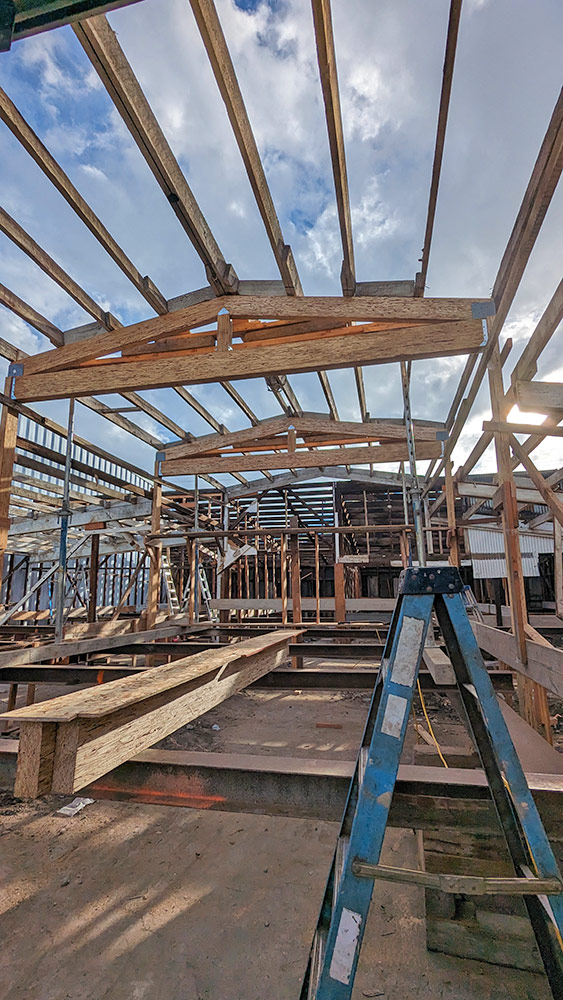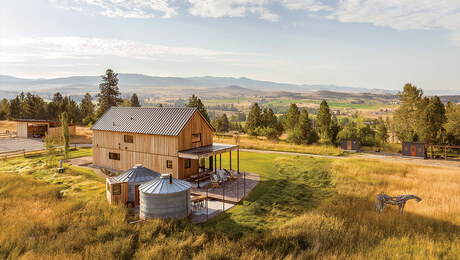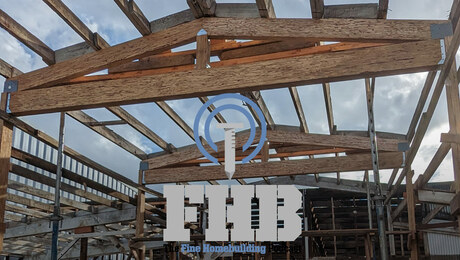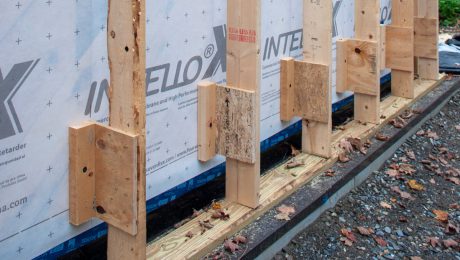Podcast 618: Heather Clark of the White House Climate Policy Office
A talk with Heather Clark Director of Building Emissions for the White House Climate Policy Office and feedback on missing water, Bay Area renovations, and PEX manifolds.
Follow the Fine Homebuilding Podcast on your favorite app. Subscribe now and don’t miss an episode:
 |
Brian and Patrick ask Heather Clark about White House efforts to help builders and improve the built environment. Zak has thoughts on missing municipal water. Chris shares an update on his business-office build. Ken says we missed the point on PEX manifolds.
Editor Updates:
- Conversation with Heather regarding her work with the White House
Listener Feedback 1:
In episode 614, Jon wondered where his coworker’s municipal water was going. He was billed for 76,000 gallons of water.
Zak Kuegler, director of engineering at Snyder Engineering (community and municipal water systems), writes:
Good Morning Patrick,
Regarding the high meter reading, the best course of action would be for Jon’s coworker to contact the utility and notify them of the high meter reading and ask them to reread the meter. As you noted it could be as simple as a misread of this quarter’s meter reading. Jon’s coworker was smart to check to confirm the meter was not spinning without any usage and barring any irrigation that took place late in the year or seasonal lines that may have a leak that were since turned off, my guess would be a bad read. Regardless, the utility has an interest to verify the accuracy of the reading and whether or not this amount of water is in fact being utilized, as it affects their unaccounted for water calculations and could affect their ability to serve other customers. Utilities we work with have staff dedicated to leak detection and verifying items like this.
I’m usually focused on the water at the other end of the delivery process, but hopefully this helps!
Best, Zak
Related Links:
Listener Feedback 2:
Follow-up to discussion in Podcast 595 about Chris’ recent property acquisition:
I’m sorry it’s been a while. My wife is very excited that you chose to talk about our project.

From there we started replacing what seems like half of the original wood. There was a lot of wood-boring beetle damage; there were a lot of old members that were bowed or crowned; and there were a lot of undersized members that needed replacement. We used lots of PSLs (no steel) to replace the original double 2x beams. The clerestory section will have five windows and a fair amount of Simpson straps to keep that part of the building together during an earthquake.
Our next challenge is to underpin the foundation and pour the grade beams and post footings. (We found that the existing foundation didn’t have an existing footing – instead it was only resting on the old slab). Hopefully we can keep the foundation intact while we dig under it, form the new footings, and pour.
Here’s a timeline of events in trying to get this project moving:
- August 2022: closed
- Late October 2022: applied for planning approval for work/live
- Mid December 2022: zoning approved (letter given 12/8, then 10 days later to make official)
- March 16, 2023: plans submitted
- April 10, 2023: they put our plans on hold until we submitted a waste-management plan
- May 25, 2023: City figured out their own code inconsistencies that made our project technically illegal and then finally approved how the project could be used
- September 13, 2023: permit “ready to be issued”
- September 21, 2023: permit finally issued (more fees, payment for plans to be printed, wait for plans to be delivered…)
Of note: Before approval it took four revisions of plans and two plan deferments (waiting on sprinkler approval and engineered drawings for a sliding gate).
Because it’s work/live, they are having us comply with commercial codes including requiring us to get sprinklers (a 4-in. line straight from the city’s main), 400A panel, ADA accessibility throughout, etc.
Yes, the Bay Area is difficult to build in, and yet we wonder why housing costs so much.
Thanks, Chris
Related Links:
- Retrofitting Footings When Digging in an Old Basement
- Three Types of Footing to Support Foundation Walls
Listener Feedback 3:
Ken from Reno, NV, writes: I have a couple comments.
- You missed the entire main point of a manifold for PEX: the hot-water distribution system. There are comfort (and energy- and water-saving) advantages to using a manifold at/near the water heater and sending separate, correctly sized PEX to each use item. The advantage for, say, a remote master bathroom sink is that my wife doesn’t have to run the water for a million years waiting for hot water to flow throw a ¾-in. supply line with a tee fitting near the sink, which likely only needs 3/8 in. or even ¼ in.! Not only does it take longer to get to her, it wastes the water. Repeat this waste for remote showers waiting to get hot, as well as kitchens, dishwashers, washing machines, etc. You would never do such a manifold with individual lines for copper because of the cost! But PEX lets you do this. I’m not sure I would do it with the cold water though, other than reducing fittings in inaccessible locations as you noted.
- On the MRCOOL heat pump discussion: if you need a relatively inexpensive system for a workshop or garage, I say go for it. But people are installing multiple MRCOOLs for their entire house. That type of approach—with bundled-up coils of excess refrigerant lines, failure to use cover trays, lower performance, etc.—has no place in Fine Homebuilding, because it violates the definition of “Fine.” Don’t sink to that level. Leave important HVAC system design and installs to the pros, who will also do proper Manual Js, routing, service, etc.
Otherwise, carry on!
Related Links:
- Three Designs for PEX Plumbing Systems
- Hot-Water Circulation Loops
- DIY ductless minisplit
- Critical Details for Ductless Heat Pumps
Podcast 618: Members-only Aftershow — FHB Content Preview 2024
Andres, Brian, and Patrick talk about recent photo and video shoots, upcoming tool tests, feature articles and E-learning courses.
This episode of The Fine Homebuilding Podcast is brought to you by Humboldt

As natural wood species go, redwood is in a class of its own. A sustainable alternative to tropical hardwoods, redwood is grown and harvested to the highest environmental standards in the world. Named for the dark red heartwood at the center of the tree, redwood imparts natural beauty, warmth, and durability to interior and exterior building applications including decking, fencing, paneling, siding, exposed beams and timbers, pergolas, and other shade structures.
To learn more about redwood from Humboldt Sawmill, please visit GetRedwood.com.
Check out one of our latest Project Guides: Energy Retrofit!
Check out our FHB Houses:
Visit the Taunton Store • Magazine Index • Online Archive • Our First Issues • All Access

If you have any questions you would like us to dig into for a future show, shoot an email our way: [email protected].
If we use your question we’ll send you a FHB Podcast sticker!
FHB Podcast T-shirts!
Represent your favorite podcast! Available in several styles and colors. Made from 100% cotton. Find the Podcast t-shirt and more cool products in the Fine Homebuilding Store.
| Fine Homebuilding podcast listeners can now get 20% off anything in the Taunton store, including Pretty Good House.
Use the discount code FHBPODCAST to take advantage of this special offer. |
 |
“Finally, knowledgeable people talking about building reasonably-sized, high-performance houses for normal people with real budgets!” — DanD, VA, 8/19/22, Amazon.com review |
We hope you will take advantage of a great offer for our podcast listeners: A special 20% off the discounted rate to subscribe to the Fine Homebuilding print magazine. That link goes to finehomebuilding.com/podoffer.
The show is driven by our listeners, so please subscribe and rate us on iTunes or Google Play, and if you have any questions you would like us to dig into for a future show, shoot an email our way: [email protected]. Also, be sure to follow Fine Homebuilding on Instagram, and “like” us on Facebook. Note that you can watch the show above, or on YouTube at the Fine Homebuilding YouTube Channel.
The Fine Homebuilding Podcast embodies Fine Homebuilding magazine’s commitment to the preservation of craftsmanship and the advancement of home performance in residential construction. The show is an informal but vigorous conversation about the techniques and principles that allow listeners to master their design and building challenges.
Other related links
-
- All FHB podcast show notes: FineHomebuilding.com/podcast.
- #KeepCraftAlive T-shirts and hats support scholarships for building trades students. So order some gear at KeepCraftAlive.org.
- The direct link to the online store is here.

































